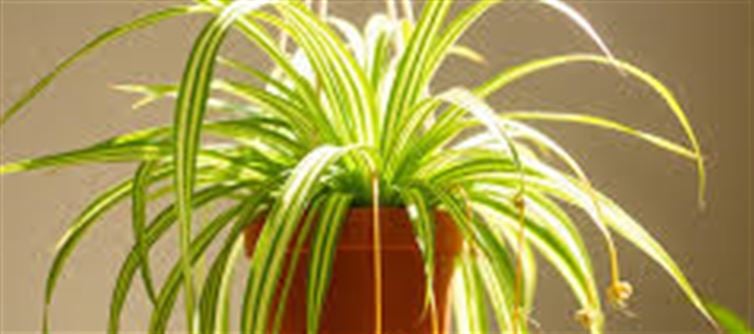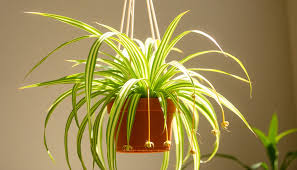
Spider plants (Chlorophytum comosum) are one of the most popular houseplants, loved for their air-purifying qualities, attractive green-and-white striped leaves, and ability to thrive in various indoor environments. While they typically prefer bright, indirect sunlight, spider plants are also known for their adaptability and can survive in lower-light conditions. If you're wondering how to keep your spider plant healthy in a space with less natural light, don't worry—this guide will help you nurture this resilient plant even in dimmer rooms.
Why Spider Plants Are Ideal for Low-Light Environments
Spider plants are native to tropical and subtropical regions, and while they thrive in bright light, they have evolved to tolerate lower-light conditions, making them an excellent choice for office spaces, bathrooms, or rooms with small windows. Here’s why they adapt well to low-light environments:
· Low-Light Tolerance: Spider plants can photosynthesize in low light, though they may not grow as vigorously as they would in brighter conditions.
· Resilient Growth: They are hardy plants that can survive in a variety of conditions, making them an excellent choice for beginners or busy individuals.
· Air-Purifying: Even in lower light, spider plants will continue to purify the air, removing toxins like formaldehyde and xylene, making them a great addition to any room.
Tips for Growing a Healthy Spider Plant in Low Light
Even though spider plants can tolerate lower light, there are a few key tips to help them thrive and maintain their vibrant appearance.
1. Choose the Right Spot
While spider plants are adaptable, light conditions still play a significant role in their growth. To ensure your plant thrives in a low-light environment:
· Indirect Light: Spider plants do best in indirect light, even in dimly lit rooms. Place your spider plant near a north- or east-facing window, where it will get some natural light but not direct rays.
· Avoid Dark Corners: Even though spider plants tolerate low light, they shouldn't be placed in extremely dark or windowless rooms. If possible, place them near a light source that stays on for several hours each day.
2. Adjust Watering Needs
In low-light conditions, spider plants require less water because the soil will dry out more slowly. Overwatering can lead to root rot, especially in dimly lit spaces where the plant’s metabolism slows down. Here’s how to manage watering:
· Let the soil dry out between waterings. Stick your finger about an inch into the soil to check for moisture before adding water.
· Reduce watering frequency in winter or during low-light periods, when the plant is in a dormant phase.
3. Keep an Eye on Temperature and Humidity
Spider plants prefer moderate temperatures and higher humidity levels. In low-light conditions, the lack of sunlight can cause the plant to require less energy, meaning you don’t need to worry about temperature fluctuations as much.
· Ideal Temperature: Keep the temperature between 60-75°F (15-24°C).
· Humidity: Spider plants thrive in higher humidity but are generally adaptable. If the air is too dry, consider placing a humidifier nearby or spraying the leaves with water occasionally to maintain humidity.
4. Fertilize Sparingly
Spider plants don't need heavy feeding, especially when grown in low-light conditions. Over-fertilizing can lead to weak growth and browning tips, particularly in poor light. To help your plant grow:
· Use a balanced, water-soluble fertilizer every 4-6 weeks during the growing season (spring and summer).
· Skip fertilizing in the fall and winter when the plant is less active and needs fewer nutrients.
5. Pruning for Healthy Growth
Even in low light, spider plants will occasionally send out baby plantlets (or “spiderettes”), which are tiny offshoots that can be propagated. However, these shoots may not be as abundant in low-light conditions. Regular pruning will help keep the plant neat and encourage better growth.
· Trim dead or yellowing leaves to help the plant conserve energy.
· Remove baby plantlets once they have roots and can be propagated or repotted.
6. Check for Pests
Spider plants are relatively pest-resistant, but they can still attract pests like spider mites or aphids, especially in low-light, humid conditions. Regularly check your plant’s leaves for any signs of pests and address them quickly:
· Wipe the leaves with a damp cloth to remove any dust, pests, or cobwebs.
· If you notice any signs of an infestation, treat the plant with insecticidal soap or neem oil.
Common Issues in Low-Light Conditions and Solutions
1. Yellowing Leaves
Yellowing leaves are a common issue in low-light environments, and they may indicate overwatering or a lack of light. If your spider plant’s leaves are turning yellow, here's what to do:
· Adjust watering: Ensure you are not overwatering. Allow the top layer of soil to dry before watering again.
· Increase light exposure: Try moving the plant to a slightly brighter spot, even if it's still indirect light.
2. Slow Growth
In low light, spider plants may not grow as fast, but this is natural. To encourage healthier growth:
· Be patient: Spider plants will grow slowly but steadily in low light, so don’t be discouraged by slow progress.
· Add a grow light: If you notice the plant is struggling, consider using a grow light to provide it with additional light, even in a low-light room.
Conclusion
Spider plants are incredibly versatile and can thrive in a variety of conditions, including low-light environments. By understanding their needs and providing the right care, even a dimly lit room can become home to a thriving spider plant. Remember to:
· Place the plant in indirect light.
· Adjust your watering and fertilizing routines to suit its slower growth in lower light.
· Prune regularly and watch for any signs of pests.
With a little attention and the right conditions, your spider plant can flourish, purifying the air and adding a touch of greenery to any indoor space, regardless of how much natural light it receives.
Disclaimer:
The views and opinions expressed in this article are those of the author and do not necessarily reflect the official policy or position of any agency, organization, employer, or company. All information provided is for general informational purposes only. While every effort has been made to ensure accuracy, we make no representations or warranties of any kind, express or implied, about the completeness, reliability, or suitability of the information contained herein. Readers are advised to verify facts and seek professional advice where necessary. Any reliance placed on such information is strictly at the reader’s own risk.




 click and follow Indiaherald WhatsApp channel
click and follow Indiaherald WhatsApp channel